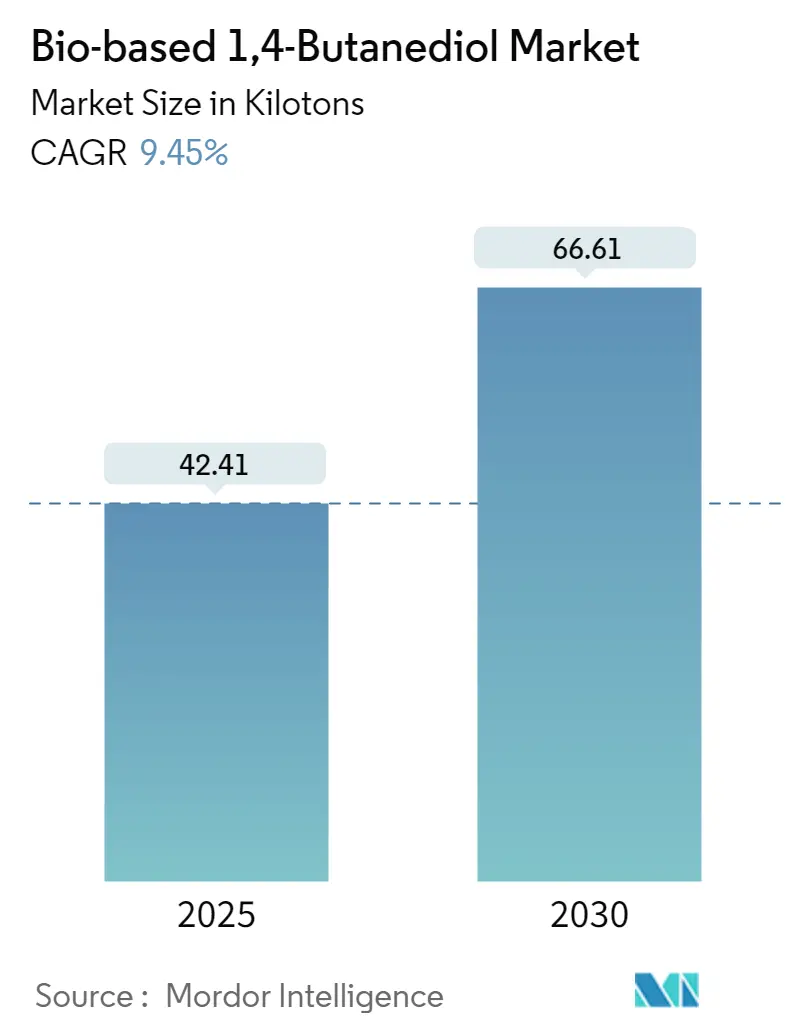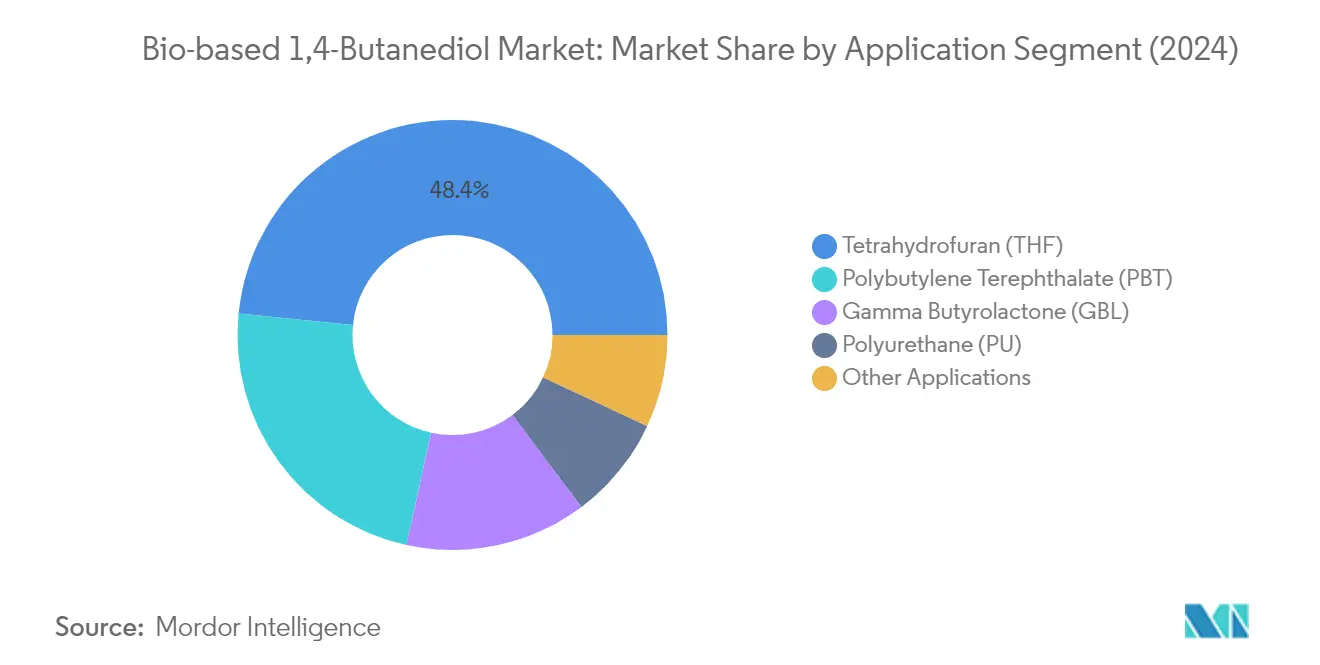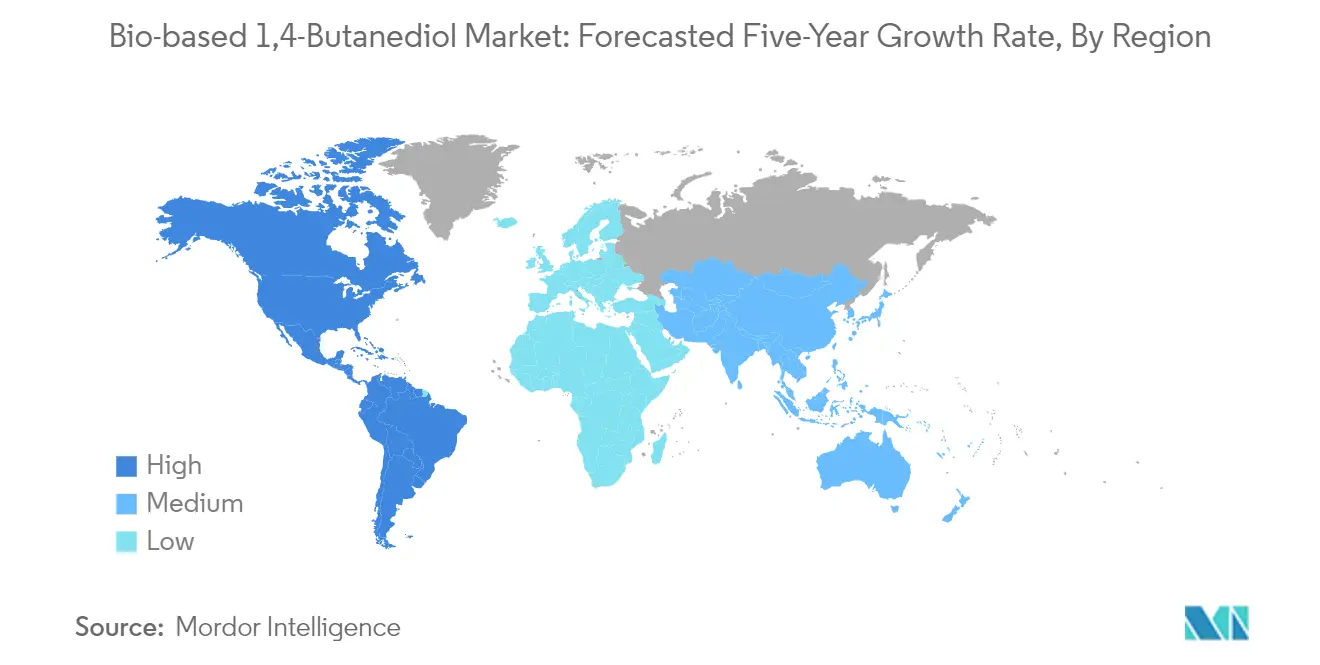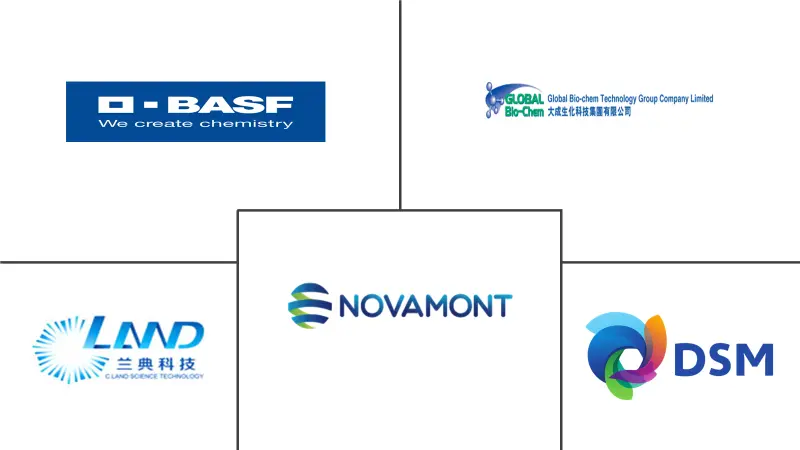Bio-based 1,4-Butanediol Market Size and Share

Bio-based 1,4-Butanediol Market Analysis by Mordor Intelligence
The Bio-based 1,4-Butanediol Market size is estimated at 42.41 kilotons in 2025, and is expected to reach 66.61 kilotons by 2030, at a CAGR of 9.45% during the forecast period (2025-2030).
The biochemical industry, particularly the bio-based 1,4-butanediol sector, is experiencing a significant transformation driven by the global shift towards sustainable manufacturing practices and circular economy principles. The electronics manufacturing sector, a major end-user of bio-based chemicals like 1,4-butanediol, demonstrated robust growth with global production reaching USD 3,436.8 billion in 2022, indicating strong demand for sustainable materials in electronic components and devices. This transformation is particularly evident in the development of eco-friendly electronic components, where manufacturers are increasingly incorporating bio-based polymers into their production processes. The industry's evolution is further supported by technological advancements in fermentation processes and improved efficiency in converting renewable feedstocks into bio-based chemicals.
The automotive sector's transition towards sustainable materials has created new opportunities for biochemical applications, particularly in electric vehicles and lightweight components. The global sports equipment market, another significant consumer of bio-based chemicals, generated revenue of USD 150,624 million in 2022, with a projected CAGR of 6.53% during 2022-2026, highlighting the growing demand for sustainable materials in consumer goods. This trend is particularly evident in the production of performance materials and technical textiles, where bio-based polymers are increasingly preferred over conventional petroleum-based products.
Innovation in production technologies has led to significant improvements in the quality and consistency of biochemical products like bio-based 1,4-butanediol, making it more competitive with conventional petroleum-based alternatives. Major industry players are investing in research and development to optimize production processes and reduce costs, with several companies announcing capacity expansions and new facility constructions. For instance, in September 2022, The LYCRA Company announced plans to produce bio-derived spandex using QIRA bio-based 1,4-BDO, marking a significant advancement in sustainable textile production.
The industry is witnessing a strategic shift in supply chain dynamics, with manufacturers focusing on establishing regional production capabilities to ensure supply security and reduce transportation costs. Companies are increasingly forming strategic partnerships and joint ventures to strengthen their market position and expand their production capabilities. The integration of advanced biotechnology processes and the development of more efficient production methods are enabling manufacturers to achieve better yields and product quality, contributing to the overall bio-based chemicals market growth. These developments are supported by increasing collaboration between chemical companies, biotechnology firms, and end-users to develop innovative applications and improve product performance, further enhancing the bio-based chemicals market size.
Global Bio-based 1,4-Butanediol Market Trends and Insights
Increasing Demand for Polybutylene Terephthalate (PBT)
Bio-based 1,4-Butanediol is essential in producing polybutylene terephthalate (PBT), a semi-crystalline thermoplastic polyester that offers superior properties, including high impact strength, excellent electrical resistance, and exceptional chemical resistance. These characteristics make PBT increasingly valuable in automotive applications, where it is used in various components, including dashboards, cockpits, steering wheels, front and rear end parts, bumpers, and electrical connectors. The material has become particularly crucial in electric vehicle manufacturing, where it is utilized in EV chargers, connectors, and various other components that require high heat resistance and durability. The growing adoption of electric vehicles globally has created additional demand streams for PBT, as demonstrated by the German automotive sector's production of 3.67 million vehicles in 2022, marking an 11% growth from the previous year.
The electronics and electrical industry represents another significant driver for PBT demand, particularly in applications requiring high-performance insulation and durability. The material's rapid crystallization rate and excellent processability make it ideal for manufacturing electronic housings, connectors, and appliance casings. This demand is evidenced by the robust growth in electronics manufacturing, with Germany's electro and digital industry alone recording a turnover of EUR 239 billion in 2023, representing a 6% increase from 2022. Additionally, PBT's application in consumer goods continues to expand, particularly in sporting goods and athletic wear, where its durability and performance characteristics are highly valued. The Bombay Stock Exchange's projection of 92% growth in India's sports and athleisure retail market by 2025 compared to 2022 levels indicates the growing demand for PBT-based materials in consumer applications.
Stringent Government Regulations
Environmental regulations and sustainability initiatives worldwide are driving the adoption of bio-based chemicals like bio-based 1,4-butanediol as industries face increasing pressure to reduce their carbon footprint. Bio-based chemicals offer significant environmental advantages, with studies showing they can reduce greenhouse gas emissions by up to 60% compared to conventional petroleum-based production methods. Companies like Qira have demonstrated even more impressive results, with their next-generation BDO showing potential to reduce greenhouse gas emission levels by 93% compared to conventional production methods. These substantial environmental benefits align with various government initiatives and regulatory frameworks aimed at promoting sustainable manufacturing practices and reducing industrial carbon emissions.
The shift toward eco-friendly products is further reinforced by consumer preferences and corporate sustainability commitments. Major manufacturers and end-user industries are increasingly adopting bio-based monomers and materials to meet environmental standards and satisfy growing consumer demand for sustainable products. This trend is particularly evident in the European Union, where regulations mandate significant reductions in greenhouse gas emissions, including an intermediate target of at least 55% net reduction by 2030. The regulatory landscape has also influenced the footwear and textile industries, as demonstrated by the 4% growth in German footwear retail sales in 2023, partially driven by consumer preference for sustainable materials. These regulations have created a favorable environment for bio-based polymers market producers, as companies throughout the supply chain seek to comply with environmental standards while maintaining product performance and quality.
Segment Analysis: By Application
Tetrahydrofuran (THF) Segment in Bio-based 1,4-Butanediol Market
Tetrahydrofuran (THF) dominates the bio-based 1,4-butanediol market, commanding approximately 48% of the total market share in 2024. THF's market leadership is primarily driven by its extensive use as a chemical building block in producing a wide range of commercial and consumer applications, including engineering plastics, polyurethanes, biodegradable polyesters, spandex, and other specialty chemicals. The segment's strong position is further reinforced by its critical role in producing polytetramethylene ether glycol (PTMEG), which is essential for bio-based spandex fiber manufacturing. THF's versatility as a solvent for polyvinyl chloride (PVC) and varnishes, combined with its ability to dissolve many nonpolar and polar chemical compounds, has established its prominence in various industrial applications. The segment's growth is particularly notable in Asia, which accounts for over 80% of the world's THF consumption, including captive production for PTMEG, primarily driven by the region's rapidly expanding bio-based spandex market.

Polybutylene Terephthalate (PBT) Segment in Bio-based 1,4-Butanediol Market
The Polybutylene Terephthalate (PBT) segment is experiencing remarkable growth in the bio-based 1,4-butanediol market, projected to expand significantly from 2024 to 2029. This growth is primarily fueled by PBT's increasing adoption in automotive applications, including dashboards, cockpits, steering wheels, front and rear end parts, bumpers, and connectors. The segment's expansion is further accelerated by its growing utilization in electric vehicle components, particularly in EV chargers, connectors, and various other applications. PBT's exceptional properties, including high impact strength, superior electrical resistance, and outstanding chemical resistance, make it increasingly indispensable in electrical and electronics applications. The material's rapid crystallization rate and lower molding temperatures compared to many engineering plastics have also contributed to its growing preference among manufacturers. Additionally, the segment's growth is supported by increasing applications in consumer electronics, telecommunications, and IT sectors, where PBT's unique combination of properties makes it ideal for various components and housings.
Remaining Segments in Bio-based 1,4-Butanediol Market by Application
The remaining segments in the bio-based 1,4-butanediol market include Gamma-Butyrolactone (GBL), Polyurethane (PU), and other applications, each serving distinct industrial needs. GBL plays a crucial role in electronics, pharmaceuticals, agrochemicals, and high-performance polymers, benefiting from its unique combination of solvent and electrical properties. The Polyurethane segment maintains its significance through applications in rigid and flexible foams, varnishes, coatings, adhesives, and fibers such as spandex. Other applications encompass various specialized uses including N-methyl pyrrolidone (NMP), N-ethyl pyrrolidone (NEP), and 2-pyrrolidone (PYR), which find applications in pharmaceuticals, cosmetics, and industrial processes. These segments collectively contribute to the market's diversity and provide essential solutions across multiple industries.
Segment Analysis: End-User Industry
Textile Segment in Bio-based 1,4-Butanediol Market
The textile segment dominates the bio-based 1,4-butanediol market, commanding approximately 42% of the market share in 2024. This segment's prominence is primarily driven by the extensive use of bio-based 1,4-butanediol as an adhesive in leather, plastics, polyester laminates, and polyurethane footwear manufacturing. Additionally, it serves as a crucial intermediate chemical in producing thermoplastic polyurethane (TPU), which is essential in synthetic leather sole material production. The segment is also witnessing the strongest growth trajectory, expected to expand by around 61% between 2024 and 2029, largely due to increasing demand for bio-based elastane fiber production. The growth is further supported by the rising adoption of bio-based polyester materials in sportswear, activewear, and technical textiles, particularly in regions like Europe and North America where sustainability initiatives are gaining significant traction.
Remaining Segments in End-User Industry
The automotive and electrical & electronics segments, along with other end-user industries, constitute the remaining market share in the bio-based 1,4-butanediol industry. The automotive sector utilizes bio-based 1,4-butanediol in manufacturing various components, including dashboards, cockpits, steering wheels, and bumpers, while also serving the growing electric vehicle market. The electrical and electronics segment employs the material in producing insulation materials, electronic housings, and various components due to its excellent electrical resistance properties. Other end-user industries, including healthcare, pharmaceuticals, construction, and packaging, utilize bio-based 1,4-butanediol in diverse applications ranging from medical textiles to biodegradable packaging solutions, contributing to the market's overall growth and diversification.
Bio-based 1,4-Butanediol Market Geography Segment Analysis
Bio-based 1,4-Butanediol Market in Asia-Pacific
The Asia-Pacific region represents a significant market for bio-based chemicals, driven by rapid industrialization and increasing adoption of sustainable materials across key economies. Countries like China, India, Japan, and South Korea are witnessing growing demand from various end-use industries, including automotive, electronics, and textiles. The region's strong manufacturing base, particularly in the electronics and automotive sectors, combined with government initiatives promoting the bio-based chemicals market, creates favorable conditions for market growth. Rising environmental consciousness and stringent regulations regarding carbon emissions are further accelerating the transition towards bio-based polymers in the region.

Bio-based 1,4-Butanediol Market in China
China emerges as the dominant force in the Asia-Pacific bio-based chemicals market, leveraging its robust manufacturing infrastructure and expanding end-use industries. The country's massive electronics manufacturing sector, being the world's largest, drives substantial demand for bio-based chemicals in various applications. China's automotive industry, particularly the electric vehicle segment, continues to expand rapidly, creating additional demand for bio-based polymers. The country's focus on sustainable development and environmental protection policies has encouraged many manufacturers to shift towards bio-chemical alternatives. Chinese companies are also investing in research and development to enhance their bio-based chemicals production capabilities.
Bio-based 1,4-Butanediol Market in India
India represents the fastest-growing market for bio-based chemicals in the Asia-Pacific region, supported by rapid industrialization and an increasing focus on sustainable manufacturing practices. The country's expanding automotive sector, growing electronics manufacturing base, and flourishing textile industry are key drivers for market growth. Government initiatives like "Make in India" and policies promoting sustainable materials have created a conducive environment for bio-chemical adoption. The country's rising environmental consciousness and commitment to reducing carbon emissions are encouraging manufacturers to incorporate bio-based chemicals in their production processes. India's strong growth trajectory is further supported by increasing investments in research and development and expanding manufacturing capabilities.
Bio-based 1,4-Butanediol Market in North America
North America represents a mature market for bio-based 1,4-butanediol, characterized by advanced manufacturing capabilities and a strong focus on sustainable technologies. The region, comprising the United States, Canada, and Mexico, demonstrates significant demand driven by various end-use industries, including automotive, electronics, and textiles. The presence of major market players and continuous technological advancements in bio-based chemicals market production strengthens the regional market. Environmental regulations and increasing consumer preference for sustainable products further support market growth across the region.
Bio-based 1,4-Butanediol Market in United States
The United States leads the North American bio-based chemicals market, accounting for approximately 65% of the regional market share in 2024. The country's leadership position is supported by its advanced manufacturing capabilities and strong presence in key end-use industries. The robust automotive sector, particularly the growing electric vehicle segment, drives significant demand for bio-based chemicals. The country's well-established electronics manufacturing industry and increasing focus on sustainable materials in various applications further strengthen market growth. Continuous investments in research and development and technological advancements maintain the United States' dominant position in the market.
Bio-based 1,4-Butanediol Market in Mexico
Mexico emerges as the fastest-growing market for bio-based 1,4-butanediol in North America, driven by rapid industrialization and increasing foreign investments in manufacturing sectors. The country's growing automotive industry and expanding electronics manufacturing base create substantial demand for bio-based materials. Mexico's strategic location and trade agreements with major economies enhance its position as a manufacturing hub. The government's support for sustainable manufacturing practices and environmental protection initiatives further accelerates market growth. The country's developing infrastructure and increasing focus on technological advancement continue to attract investments in bio-based chemicals production.
Bio-based 1,4-Butanediol Market in Europe
Europe stands as the global leader in the bio-based chemicals market, with a comprehensive network of manufacturers and end-users spread across Germany, the United Kingdom, France, Italy, and other countries. The region's strong commitment to sustainability and circular economy principles drives significant adoption of bio-based chemicals. Advanced manufacturing capabilities, stringent environmental regulations, and continuous technological innovations characterize the European market. The presence of major market players and robust research and development activities further strengthen Europe's position in the global market.
Bio-based 1,4-Butanediol Market in Germany
Germany maintains its position as the largest market for bio-based chemicals in Europe, supported by its advanced manufacturing capabilities and strong presence in key end-use industries. The country's robust automotive sector, including its growing electric vehicle segment, drives substantial demand for bio-based chemicals. Germany's leadership in industrial automation and manufacturing technology contributes to efficient production and utilization of bio-based chemicals. The country's strong focus on environmental sustainability and circular economy principles further supports market growth. Continuous investments in research and development maintain Germany's competitive edge in the market.
Bio-based 1,4-Butanediol Market in France
France emerges as the fastest-growing market for bio-based chemicals in Europe, driven by increasing adoption of sustainable materials across various industries. The country's strong focus on environmental protection and commitment to reducing carbon emissions accelerates the transition towards bio-based chemicals. France's growing automotive sector, particularly in electric vehicles, creates substantial demand for sustainable materials. The government's support for green technologies and circular economy initiatives further strengthens market growth. Continuous investments in research and development and expanding manufacturing capabilities maintain France's growth momentum in the market.
Bio-based 1,4-Butanediol Market in Rest of World
The Rest of World region, encompassing South America and the Middle East & Africa, represents an emerging market for bio-based chemicals with growing potential. These regions are witnessing increasing awareness about sustainable materials and growing industrial activities. In South America, Brazil emerges as both the largest and fastest-growing market, driven by its expanding automotive and textile industries. The Middle East & Africa region shows promising growth potential, particularly in countries focusing on diversifying their economies and adopting sustainable technologies. While the current market share remains modest, ongoing industrialization and increasing environmental consciousness are expected to drive future growth in these regions.
Competitive Landscape
Top Companies in Bio-based 1,4-Butanediol Market
The bio-based chemicals market is characterized by companies focusing on sustainable production methods and technological innovation. Leading players are investing heavily in R&D to improve fermentation processes and develop more efficient production techniques. Strategic collaborations with technology providers like Genomatica have become crucial for market entry and expansion, as demonstrated by partnerships with major chemical companies. Companies are also emphasizing vertical integration, from securing renewable feedstock supplies to establishing end-product manufacturing capabilities. The industry is witnessing increased focus on capacity expansion through greenfield projects and joint ventures, particularly in regions with strong sustainability mandates. Operational agility is being enhanced through diversified feedstock sourcing and adoption of advanced biotechnology processes.
Oligopolistic Market with High Entry Barriers
The bio-based 1,4-butanediol market exhibits a highly concentrated structure dominated by a few major players, primarily Novamont SpA and Shandong Landian Biological Technology. These companies have established strong market positions through their early adoption of bio-based technologies and significant production capacities. The bio-based chemicals market is characterized by high entry barriers due to complex production technologies, substantial capital requirements, and the need for specialized expertise in biotechnology processes. The industry has witnessed strategic consolidation through joint ventures and technology licensing agreements, particularly involving established chemical companies seeking to enter the bio-based segment.
The competitive landscape is evolving with the emergence of new players through strategic partnerships and joint ventures, such as the Qira joint venture between Cargill and HELM. Market consolidation is primarily driven by the need to access proprietary technology, secure sustainable feedstock supply chains, and achieve economies of scale. Global chemical conglomerates are increasingly entering the market through partnerships with technology providers and bio-based specialists, indicating a shift towards more sustainable production methods in the chemical industry.
Innovation and Sustainability Drive Future Success
Success in the bio-based 1,4-butanediol market increasingly depends on technological innovation, sustainable practices, and strategic partnerships. Incumbent players must focus on continuous process improvement, cost reduction through scale economies, and strengthening their vertical integration capabilities. Companies need to invest in research and development to enhance production efficiency and develop new applications for biochemical products. Building strong relationships with both feedstock suppliers and end-users while maintaining technological leadership through partnerships with research institutions and technology providers is crucial for maintaining market position.
For new entrants and smaller players, success lies in identifying niche market segments and developing specialized applications for bio-based 1,4-butanediol. Companies must navigate regulatory requirements and sustainability certifications while building robust supply chains for renewable feedstock. The ability to offer competitive pricing against conventional petroleum-based alternatives remains crucial, particularly in price-sensitive markets. Future growth opportunities will be influenced by increasing environmental regulations, growing consumer preference for sustainable products, and the development of new applications in various end-user industries, including the bio-based polymers market.
Bio-based 1,4-Butanediol Industry Leaders
-
Novamont SpA
-
Shandong LanDian Biological Technology Co. Ltd
-
DSM
-
BASF SE
-
Global Bio-chem Technology Group Company Limited
- *Disclaimer: Major Players sorted in no particular order

Recent Industry Developments
- September 2023: BASF SE obtained long-term access to bio-based 1,4-butanediol Qira from Qore LLC (Qore), a joint venture of Cargill and Helm AG. BASF SE made this move to expand its existing offer of BDO derivatives with bio-based variants.
- March 2023: The world's first two-step process bio-BDO facility was successfully put into operation in China. The new facility was developed and built by Shandong LanDian Biological Technology Co. Ltd., the second enterprise in China to mass-produce bio-BDO after YuanLi Chemical Group Co., Ltd.
- September 2022: Qira collaborated with Lycra, a textile and apparel brand, allowing Lycra to use Qira bio-based BDO for spandex manufacturing. Through this move, 70% of Lycra’s fiber content will be derived from renewable feedstock.
Global Bio-based 1,4-Butanediol Market Report Scope
Bio-based 1,4-butanediol, majorly manufactured using sugar fermentation, is polymerized with terephthalic acid to produce polybutylene terephthalate (PBT). PBT is a semi-crystalline, white, or off-white thermoplastic polyester with higher impact strength, better electrical resistance, and exceptional chemical resistance. Such PBT properties make it widely suitable for applications in the electrical and electronics, telecommunications and IT, and automotive industries.
The bio-based 1,4 butanediol market is segmented by application, end-user industry, and geography. By application, the market is segmented into tetrahydrofuran (THF), polybutylene terephthalate (PBT), gamma-butyrolactone (GBL), polyurethane (PU), and other applications (polybutylene succinate (PBS), etc.). By end-user industry, the market is segmented into automotive, electrical and electronics, textile, and other end-user industries. The report also covers the market size and forecasts for the bio-based 1,4 butanediol market in 27 countries across major regions. For each segment, the market sizing and forecasts were done based on volume (kilotons).
| Tetrahydrofuran (THF) |
| Polybutylene Terephthalate (PBT) |
| Gamma-Butyrolactone (GBL) |
| Polyurethane (PU) |
| Other Applications |
| Automotive |
| Electrical and Electronics |
| Textile |
| Other End-user Industries |
| Asia-Pacific | China |
| India | |
| Japan | |
| South Korea | |
| Malaysia | |
| Indonesia | |
| Vietnam | |
| Thailand | |
| Rest of Asia-Pacific | |
| North America | United States |
| Canada | |
| Mexico | |
| Europe | Germany |
| United Kingdom | |
| France | |
| Italy | |
| Russia | |
| NORDIC | |
| Spain | |
| Turkey | |
| Rest of Europe | |
| Rest of the World | South America |
| Middle East and Africa |
| Application | Tetrahydrofuran (THF) | |
| Polybutylene Terephthalate (PBT) | ||
| Gamma-Butyrolactone (GBL) | ||
| Polyurethane (PU) | ||
| Other Applications | ||
| End-user Industry | Automotive | |
| Electrical and Electronics | ||
| Textile | ||
| Other End-user Industries | ||
| Geography | Asia-Pacific | China |
| India | ||
| Japan | ||
| South Korea | ||
| Malaysia | ||
| Indonesia | ||
| Vietnam | ||
| Thailand | ||
| Rest of Asia-Pacific | ||
| North America | United States | |
| Canada | ||
| Mexico | ||
| Europe | Germany | |
| United Kingdom | ||
| France | ||
| Italy | ||
| Russia | ||
| NORDIC | ||
| Spain | ||
| Turkey | ||
| Rest of Europe | ||
| Rest of the World | South America | |
| Middle East and Africa | ||
Key Questions Answered in the Report
How big is the Bio-based 1,4-Butanediol Market?
The Bio-based 1,4-Butanediol Market size is expected to reach 42.41 kilotons in 2025 and grow at a CAGR of 9.45% to reach 66.61 kilotons by 2030.
What is the current Bio-based 1,4-Butanediol Market size?
In 2025, the Bio-based 1,4-Butanediol Market size is expected to reach 42.41 kilotons.
Who are the key players in Bio-based 1,4-Butanediol Market?
Novamont SpA, Shandong LanDian Biological Technology Co. Ltd, DSM, BASF SE and Global Bio-chem Technology Group Company Limited are the major companies operating in the Bio-based 1,4-Butanediol Market.
Which is the fastest growing region in Bio-based 1,4-Butanediol Market?
North America is estimated to grow at the highest CAGR over the forecast period (2025-2030).
Which region has the biggest share in Bio-based 1,4-Butanediol Market?
In 2025, the Europe accounts for the largest market share in Bio-based 1,4-Butanediol Market.
What years does this Bio-based 1,4-Butanediol Market cover, and what was the market size in 2024?
In 2024, the Bio-based 1,4-Butanediol Market size was estimated at 38.40 kilotons. The report covers the Bio-based 1,4-Butanediol Market historical market size for years: 2019, 2020, 2021, 2022, 2023 and 2024. The report also forecasts the Bio-based 1,4-Butanediol Market size for years: 2025, 2026, 2027, 2028, 2029 and 2030.
Page last updated on:



